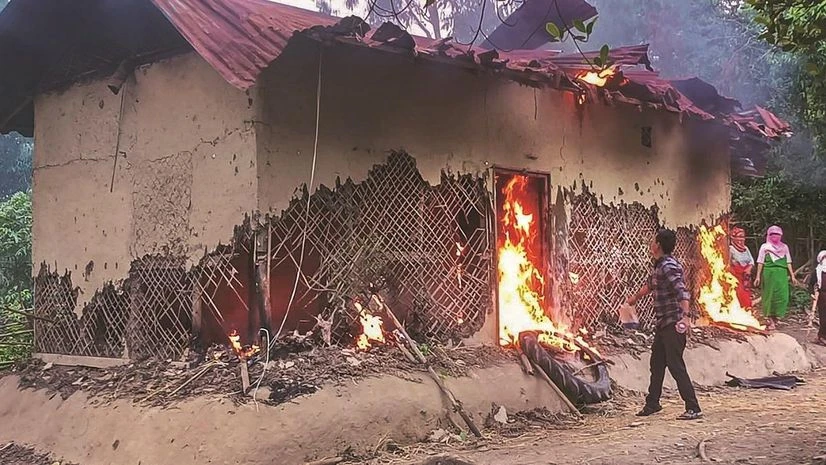The Manipur High Court has ordered deletion of a paragraph from a March 2023 order that urged the state to consider including the Meitei community in the Scheduled Tribe list saying the paragraph was in conflict with the Supreme Court's constitution bench stance.
The March 27, 2023 directive, believed to be a catalyst for ethnic unrest that claimed over 200 lives, was rescinded by a single judge bench of Justice Golmei Gaiphulshillu during a review petition hearing on Wednesday.
The contentious paragraph from last year's verdict, instructing the state to expedite consideration of Meitei community inclusion, was deemed for deletion.
The paragraph of the last year verdict stated the state government "shall consider the case of the petitioners for inclusion of Meetei/Meitei community in the Scheduled Tribes list, expeditiously, preferably within a period of four weeks" from the date of receipt of the order.
Justice Gaiphulshillu's ruling on February 21 emphasised the necessity of removing the directive, pointing to the Government of India's stipulated procedure for Scheduled Tribe list amendments.
Justice Gaiphulshillu said, "Accordingly, the direction given at para no. 17(iii) needs to be deleted and is ordered accordingly for deletion of the para no. 17(iii) of the judgment and order dated March 27, 2023...".
Referring to the constitutional protocol detailed in the Ministry of Tribal Affairs' 2013-14 report, the court highlighted the need for alignment with the Supreme Court's constitutional interpretation.
"...I am satisfied and of the view that the direction given at Para no. 17(iii) of the single judge dated March 27, 2023...which is impugned herein needs to be reviewed, as the direction given at para no. 17(iii) of the single judge is against the observation made in the constitution bench of the Supreme Court," the high court said in its 19-page verdict.
The high court's detailed 19-page verdict underlined the legislative limitations on judicial interference concerning Scheduled Tribe classifications, as outlined by a constitution bench ruling in November 2000.
"Courts cannot and should not expand jurisdiction to deal with the question as to whether a particular caste, sub-caste; a group or part of tribe or sub-tribe is included in any one of the Entries mentioned in the Presidential Orders issued under Article 341 and 342 particularly so when in Clause (2) of the said Article, it is expressly stated that said orders cannot be amended or varied except by law made by Parliament" the verdict of Supreme Court's Constitution bench in November 2000 said.
The constitution bench had elucidated that courts should not overstep their jurisdiction in determining such categorisations.
Following the eruption of violence post the March 27 order, a series of petitions, including challenges to the high court directive, were presented to the Supreme Court.
The apex court, on May 17 of the same year, denounced the high court's directive as "obnoxious" and considered staying the order due to its perceived inaccuracies.
A bench headed by Chief Justice D Y Chandrachud had said, "I will tell you (lawyers) one thing that the high court order was incorrect... I think we have to stay the order of the high court. The high court order is absolutely wrong."
The apex court bench had made clear it will not deal with legal issues arising out of the Manipur High Court's decision on grant of reservation to majority Meiteis as the pleas challenging the order were pending with the larger division bench there.
Amid the legal discourse, the Supreme Court refrained from addressing the core legal aspects arising from the Manipur High Court's decision, as the challenges were pending before a larger division bench.
The court invited tribal participation, particularly from Kukis, in the ongoing legal proceedings related to the intra-court appeals.
The violent unrest in Manipur, triggered by dissent over Meitei community's Scheduled Tribe status aspiration, underscores the complex demographic fabric of the region.
Meiteis account for about 53 per cent of Manipur's population and live mostly in the Imphal Valley, while tribals, which include Nagas and Kukis, constitute 40 per cent and reside mainly in the hill districts.
The Manipur High Court's decision to delete a paragraph from its March 2023 order which urged the state to consider including the Meitei community in the Scheduled Tribe list, has evoked contrasting reactions from the two warring communities in the northeastern state.
While Meitei organisations said it will continue the movement for ST status for the community claiming it is not just a matter of the judiciary, a Kuki bodies welcomed the verdict asserting that it is the right decision.
Keithelakpam Bhogen, the general secretary of the Scheduled Tribe Demand Committee Manipur (STDCM), expressed determination to continue the movement for ST status for the Meitei community despite the court's decision.
He said the issue is not solely a judicial matter and vowed to persist in their efforts, including engaging with legislators.
World Meitei Council president Heigrujam Nabashyam downplayed the significance of the directive, stating that their demand for ST status would persist, unaffected by the court's decision.
The March 27, 2023 directive, believed to be a catalyst for ethnic unrest that claimed over 200 lives, was rescinded by a single judge bench of Justice Golmei Gaiphulshillu during a review petition hearing on Wednesday.
The contentious paragraph from last year's verdict, instructing the state to expedite consideration of Meitei community inclusion, was deemed for deletion.
On the other hand, the Zomi Council Steering Committee convener welcomed the high court's decision, considering it the right course of action.
ITLF media spokesperson Ginza Vualzong criticised the Meitei community's demand for ST status, characterising it as absurd and driven by ulterior motives such as land acquisition of tribals.
Vualzong argued that the Meiteis, being an advanced group with their language recognised in the Constitution, should not seek ST status.
Meiteis account for about 53 per cent of Manipur's population and live mostly in the Imphal Valley, while tribals, which include Nagas and Kukis, constitute 40 per cent and reside mainly in the hill districts.

)
